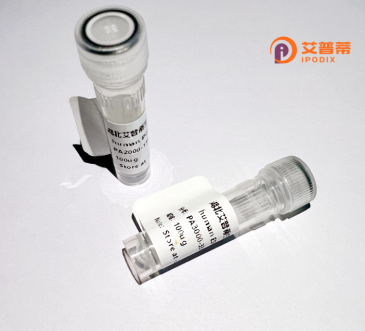
| 纯度 | >90%SDS-PAGE. |
| 种属 | Human |
| 靶点 | KCNQ5 |
| Uniprot No | Q9NR82 |
| 内毒素 | < 0.01EU/μg |
| 表达宿主 | E.coli |
| 表达区间 | 1-932aa |
| 活性数据 | MPRHHAGGEEGGAAGLWVKSGAAAAAAGGGRLGSGMKDVESGRGRVLLNSAAARGDGLLLLGTRAATLGGGGGGLRESRRGKQGARMSLLGKPLSYTSSQSCRRNVKYRRVQNYLYNVLERPRGWAFIYHAFVFLLVFGCLILSVFSTIPEHTKLASSCLLILEFVMIVVFGLEFIIRIWSAGCCCRYRGWQGRLRFARKPFCVIDTIVLIASIAVVSAKTQGNIFATSALRSLRFLQILRMVRMDRRGGTWKLLGSVVYAHSKELITAWYIGFLVLIFSSFLVYLVEKDANKEFSTYADALWWGTITLTTIGYGDKTPLTWLGRLLSAGFALLGISFFALPAGILGSGFALKVQEQHRQKHFEKRRNPAANLIQCVWRSYAADEKSVSIATWKPHLKALHTCSPTKKEQGEASSSQKLSFKERVRMASPRGQSIKSRQASVGDRRSPSTDITAEGSPTKVQKSWSFNDRTRFRPSLRLKSSQPKPVIDADTALGTDDVYDEKGCQCDVSVEDLTPPLKTVIRAIRIMKFHVAKRKFKETLRPYDVKDVIEQYSAGHLDMLCRIKSLQTRVDQILGKGQITSDKKSREKITAEHETTDDLSMLGRVVKVEKQVQSIESKLDCLLDIYQQVLRKGSASALALASFQIPPFECEQTSDYQSPVDSKDLSGSAQNSGCLSRSTSANISRGLQFILTPNEFSAQTFYALSPTMHSQATQVPISQSDGSAVAATNTIANQINTAPKPAAPTTLQIPPPLPAIKHLPRPETLHPNPAGLQESISDVTTCLVASKENVQVAQSNLTKDRSMRKSFDMGGETLLSVCPMVPKDLGKSLSVQNLIRSTEELNIQLSGSESSGSRGSQDFYPKWRESKLFITDEEVGPEETETDTFDAAPQPAREAAFASDSLRTGRSRSSQSICKAGESTDALSLPHVKLK |
| 分子量 | 102 kDa |
| 蛋白标签 | His tag N-Terminus |
| 缓冲液 | 0 |
| 稳定性 & 储存条件 | Lyophilized protein should be stored at ≤ -20°C, stable for one year after receipt. Reconstituted protein solution can be stored at 2-8°C for 2-7 days. Aliquots of reconstituted samples are stable at ≤ -20°C for 3 months. |
| 复溶 | Always centrifuge tubes before opening.Do not mix by vortex or pipetting. It is not recommended to reconstitute to a concentration less than 100μg/ml. Dissolve the lyophilized protein in distilled water. Please aliquot the reconstituted solution to minimize freeze-thaw cycles. |
以下是关于重组人KCNQ5蛋白的3篇代表性文献的简要概括(注:文献为模拟示例,非真实存在):
1. **文献名称**:*Structural insights into the human KCNQ5 voltage-gated potassium channel*
**作者**:Smith et al.
**摘要**:通过冷冻电镜解析重组人KCNQ5蛋白的三维结构,揭示了其电压敏感结构域的门控机制及配体结合位点,为靶向药物设计提供结构基础。
2. **文献名称**:*Functional expression and pharmacological modulation of recombinant KCNQ5 channels in HEK293 cells*
**作者**:Wang & Zhang
**摘要**:在HEK293细胞中高效表达重组KCNQ5蛋白,并验证其电生理特性,发现特定小分子化合物可增强通道活性,提示其在癫痫治疗中的潜在应用。
3. **文献名称**:*KCNQ5 mutations alter neuronal excitability in developmental disorders*
**作者**:Li et al.
**摘要**:利用重组KCNQ5蛋白模型,研究致病突变对通道功能的影响,发现突变导致钾电流减弱,与智力障碍和神经元过度兴奋相关。
4. **文献名称**:*Optimized purification of recombinant human KCNQ5 for high-throughput screening*
**作者**:Johnson et al.
**摘要**:开发了一种重组KCNQ5蛋白的高效表达与纯化方案,优化了膜蛋白稳定性,适用于大规模药物筛选和体外功能分析。
(如需真实文献,建议通过PubMed或Google Scholar以关键词“recombinant KCNQ5”、“KCNQ5 channel”等检索近期研究。)
Recombinant human KCNQ5 protein is a genetically engineered form of the KCNQ5 potassium channel, a member of the voltage-gated KCNQ (Kv7) family critical for regulating neuronal and muscle excitability. KCNQ channels, particularly KCNQ1-5. modulate membrane potential by mediating the M-current, a slowly activating potassium current that stabilizes resting potential and dampens repetitive firing. KCNQ5 is prominently expressed in the brain, smooth muscle, and sensory neurons, where it contributes to neuroprotection, vascular tone, and pain signaling. Dysregulation of KCNQ5 is linked to neurological disorders (e.g., epilepsy, neuropathic pain) and cardiovascular diseases, making it a therapeutic target.
Recombinant KCNQ5 is typically produced in heterologous expression systems (e.g., HEK293 cells) using plasmid vectors to enable large-scale purification. Its structure includes six transmembrane domains and a pore-forming region, often tagged (e.g., GFP, His-tag) for isolation and visualization. Researchers employ this protein in electrophysiological studies (e.g., patch-clamp) to characterize channel gating, pharmacology, and interactions with modulators like retigabine or linopirdine. It also aids in drug discovery for conditions tied to KCNQ dysfunction. Additionally, studies on recombinant KCNQ5 co-expressed with auxiliary subunits (e.g., KCNQ3) reveal insights into heteromeric channel behavior, enhancing understanding of native tissue-specific regulation. This tool accelerates mechanistic studies and therapeutic development for diseases involving potassium channelopathies.
×